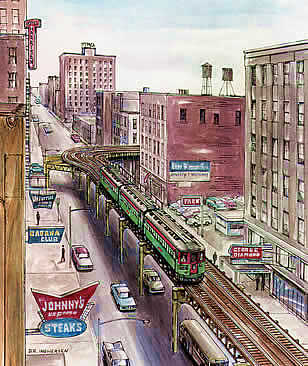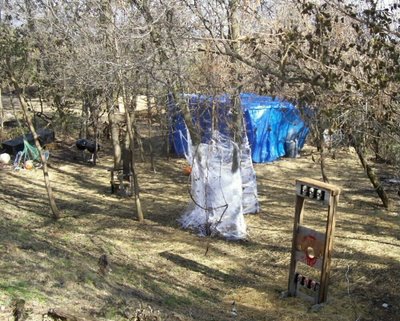I do push and by the end of the semester, the vast majority of my students are very appreciative. But I often wonder how much easier their lives would have been if they had not been shortchanged in their first 12 years of education. I know this statement will upset many teachers. However, I believe more educators need to set standards, demand excellence, and push students to do more than they think they can do. When we indirectly tell students they either are not as good as they can be or we are dishonest with them by telling them they are better than their work merits (note, not them, their work) we short change them.Standards? Excellence? Those are incongruent with the prevailing transformative vision.
31.10.06
30.10.06
“By requiring that its social workers come from CSWE-accredited schools, HHS is tacitly approving viewpoint discrimination,” FIRE President Greg Lukianoff said. “HHS should take steps to ensure that CSWE eliminates the ideological requirements it currently places on universities and students.”I have difficulty conceiving of any system of justice that is not a social institution, which leaves a "disposition" to social justice empirically empty. Presumably a hermit can opt out of any system of justice, but anyone who wishes to live by interacting with others is subject to some social system, including some notion of justice. "Economic" justice is an even more challenging topic. It's not even on the course of study in most graduate programs (although one can get at the idea indirectly using such tools as game theory, fairness theory, and law and economics.) Even there, the notion of justice is slippery. Suppose a vendor decides that offering consumers stuff cheaply is "just." Accordingly, it compels its own suppliers to compete with each other to develop the least-costly supply chain. Economic justice, or not? Suppose the suppliers define "economic justice" as obtaining the largest possible return on their efforts, and they cooperate to that end. Is the outcome more just or less? Now consider a system of economic exchange in which there are benefits from exchanging that are almost everywhere shared between the seller and the buyer, but the buyers and sellers whose exchanges determine the prices are indifferent between exchanging or not exchanging. Just, or not.
CSWE maintains a set of official standards on the basis of which it decides whether or not to accredit a social work program. The standards require that CSWE-accredited programs “integrate social and economic justice content grounded in an understanding of distributive justice, human and civil rights, and the global interconnections of oppression.” They also require that graduates of CSWE-accredited programs “demonstrate the ability to…understand the forms and mechanisms of oppression and discrimination and apply strategies of advocacy and social change that advance social and economic justice.”
“‘Social justice’ and ‘economic justice’ are vague and politically loaded terms that mean different things to different people, yet CSWE’s standards force schools to evaluate prospective social workers based on their commitment to these ideals,” Lukianoff said. “It’s an invitation for schools to discriminate against students with dissenting views, as FIRE has seen happen many times before.”
The Foundation has been busy pursuing dispositions criteria. Earlier this month, their staff asked Columbia Teachers College to remove the implicit loyalty oath in their criteria for the proper dispositions.
Teachers College’s requirement that students demonstrate a “commitment” to “social justice” crosses a line from suggesting values to which educators believe students might wish to aspire, to saying, flat out, that students will be judged on their personal political beliefs.A followup post is more specific.
Teachers College therefore advocates a transformative vision of social justice in the classroom:A successful "transformative vision" ought to improve on the existing order. As a number of observers are suggesting, the fruits by which we know this vision are poisoned. Start with Sol Stern in City Journal:To change the system and make schools and societies more equitable, educators must recognize ways in which taken-for-granted notions regarding the legitimacy of the social order are flawed, see change agency as a moral imperative, and have skills to act as agents of change (Villegas & Lucas, 2002). [Emphasis added]So must all students really come to these same conclusions? What about all the criticisms of this approach to teaching? Will students be penalized for not adopting this theoretical and political posture?
Throughout most of the twentieth century, the bad and oppressive “banking” approach that the city’s public schools used somehow managed to lift millions of children out of poverty—something the social justice schools of today seem unlikely to do."Banking" refers to teacher-as-authority placing information into youngsters' heads as coins into a bank. Although one might quibble about post-hoc inferences, graduates of those old-style schools had better basic skills than their contemporary counterparts. He goes on to suggest that the new curriculum is crowding out more useful lessons.
Social justice teaching is a frivolous waste of precious school hours, grievously harmful to poor children, who start out with a disadvantage. School is the only place where they are likely to obtain the academic knowledge that could make up for the educational deprivation they suffer in their homes. The last thing they need is a wild-eyed experiment in education through social action.I'd add to that: and develop their non-cognitive skills, such as recognizing that highly effective people have habits that contribute to their effectiveness, and bad habits have bad consequences. Too often, the lessons being learned are different. A retired New York City teacher offers one such lament about the attempt to correct for "disparate impacts" in punishment in Opinion Journal.
During the principal's hearing, as I sat across the table from the boy and his father, I recalled a classic essay that I had often taught my senior English classes. It was by George Orwell, and it recalled an unpleasant incident during his service as a policeman in Burma. Knowing that he was doing wrong, Orwell shot an elephant to save face before a mocking crowd of natives. No one suggested that we had acted incorrectly. Kids in our charge had to learn right from wrong, we told ourselves. But, more than two decades later, I still can't escape the nagging thought that, though we had other choices, better suited for the boy's welfare, at bottom all of us just wanted to get our numbers right.Here, the numbers are suspensions and expulsions, which, as is true of anything involving "disparate impact" must be in proportion to the demographics of the school population.
Unfortunately, my invocation of "habits of highly effective people" has crossed the line into an incorrect disposition according to a longer New York Post column (via Joanne Jacobs (the link may not work)).
I suppose if nobody knows the habits of highly effective people, by construction nobody will be highly effective, and there will be neither merit nor mobility. In such a world, what value is there to being a teacher? I could be more generous. Try "Social inequalities are often produced and perpetuated by systematic exclusion of the habits of highly effective people from the curriculum and justified by faddish ideology of relativism and multiculturalism." Would anyone inside the teachers' colleges be willing to debate that?Teachers College gets more specific: Students are also expected to recognize that "social inequalities are often produced and perpetuated through systematic discrimination and justified by societal ideology of merit, social mobility and individual responsibility."
Does anyone outside of academia really think that "individual responsibility" is a scourge upon our society? Is such an attitude really required in order to be a good teacher?
The opponents during the Green Bay Packers' two-game winning streak have a combined record of 2-13 and the three teams the Packers have beaten this season have a combined mark of 3-19.Yes, but if the Packers don't beat those teams, their combined record is 6-19 and one of them might have a modest winning streak going.
I was able to listen to some of Sunday's victory, which included the radio promulgation of a Man Law preventing the "toll sip" at a sporting event. I realize the Man Laws are intended to be funny, but what does it say about the world we live in that pronouncing anathema on the "toll sip" resonates?
The two paragraphs are less than coherent. Presumably it is better for a town if there is a Starbucks or five (and therefore some consumer spending leaving town) than it is if there is no Starbucks, and the local merchants keep most of the little consumer spending that there is going on in town.DeKalb uses leakage rates, the fraction of money from DeKalb being spent elsewhere, to address the question of where the rest of a consumer's money is going if it's not being spent in the area.
"Starbucks has consistently been used across the United States as an indicator on whether a particular place has a healthy economy," [DeKalb economic development administrator Paul] Rasmussen said. "Three years ago there were no Starbucks in DeKalb. Now there are five. For a small town, that's a lot."
One way to keep the consumer spending in town is to have reasons for people to spend money in town.
So experiment with such a business yourself, or be a venture capitalist to a student with such an idea.DeKalb resident Phil Pearson likes the new business developments popping up in DeKalb, but has other hopes for a town inhabited by younger people.
"I think in a university town, you want to see something fresh, original and cutting-edge," he said. "Not something so corporate like a town dominated by chains and drive-thrus."
28.10.06
CONTINGENT LIABILITIES.
To some extent, the report misleads. The entitlement programs have been contingent liabilities all along. During the late 1990s, Social Security payments in excess of current benefit payments were counted as additional general revenues, hence the government was able to show an operating surplus, even though those payments are supposed to imply future claims against the so-called trust fund. Remind me again, why was the creation of private Social Security accounts, in which an asset exists alongside a liability, such a bad idea? And Social Security is a relatively small problem. But note in the excerpt the reliance on dubious accounting. It's more accurate to say "Social Security taxes currently exceed payouts, but the government is not writing down a contingent liability for the future benefits these taxes represent."People who remember Ross Perot's rants in the 1992 presidential election may think of the federal debt as a problem of the past. But it never really went away after Perot made it an issue, it only took a breather. The federal government actually produced a surplus for a few years during the 1990s, thanks to a booming economy and fiscal restraint imposed by laws that were passed early in the decade. And though the federal debt has grown in dollar terms since 2001, it hasn't grown dramatically relative to the size of the economy.
But that's about to change, thanks to the country's three big entitlement programs - Social Security, Medicaid and especially Medicare. Medicaid and Medicare have grown progressively more expensive as the cost of health care has dramatically outpaced inflation over the past 30 years, a trend that is expected to continue for at least another decade or two.
Does anybody really think that doubling the tax rates would bring in the expected revenue stream, or would that be the mother of all contractionary fiscal policies? And I do wish reporters would be more sensitive to laws of conservation in economics.Medicare so dominates the nation's fiscal future that some economists believe health care reform, rather than budget measures, is the best way to attack the problem.
"Obviously health care is a mess," says Dean Baker, a liberal economist at the Center for Economic and Policy Research, a Washington think tank. "No one's been willing to touch it, but that's what I see as front and center."
Social Security is a much less serious problem. The program currently pays for itself with a 12.4 percent payroll tax, and even produces a surplus that the government raids every year to pay other bills. But Social Security will begin to run deficits during the next century, and ultimately would need an infusion of $8 trillion if the government planned to keep its promises to every beneficiary.
Calculations by Boston University economist Lawrence Kotlikoff indicate that closing those gaps - $8 trillion for Social Security, many times that for Medicare - and paying off the existing deficit would require either an immediate doubling of personal and corporate income taxes, a two-thirds cut in Social Security and Medicare benefits, or some combination of the two.
U.S. consumers could stop the Chinese from lending money to the government tomorrow if they wanted to. It's very simple. If consumers stop buying Chinese goods, those dollars stop accumulating in Chinese banks, and the Chinese central bank no longer has them to bid at Treasury auctions. The consequences of that choice are left to the reader as an exercise.Why is America so fiscally unprepared for the next century? Like many of its citizens, the United States has spent the last few years racking up debt instead of saving for the future. Foreign lenders - primarily the central banks of China, Japan and other big U.S. trading partners - have been eager to lend the government money at low interest rates, making the current $8.5-trillion deficit about as painful as a big balance on a zero-percent credit card.
In her part of the fiscal wake-up tour presentation, [Brookings economist Diane Lim] Rogers tries to explain why that's a bad thing. For one thing, even when rates are low a bigger deficit means a greater portion of each tax dollar goes to interest payments rather than useful programs. And because foreigners now hold so much of the federal government's debt, those interest payments increasingly go overseas rather than to U.S. investors.
More serious is the possibility that foreign lenders might lose their enthusiasm for lending money to the United States. Because treasury bills are sold at auction, that would mean paying higher interest rates in the future.
And it wouldn't just be the government's problem. All interest rates would rise, making mortgages, car payments and student loans costlier, too.
Applicants can only send two signals, so if an employer doesn’t get a signal from some applicant, that fact contains almost no information. (See advice to applicants, below, which suggests how applicants might use their signals). But because applicants can send only two signals, the signals an employer does receive convey valuable information about the candidate’s interest.The instructions for using this system are, well, instructive.
The two signals should not be thought of as indicating your top two choices. Instead, you should think about which two employers that you are interested in would be likely to interview you if they receive your signal, but not otherwise (see advice to employers, above). You might therefore want to send a signal to an employer that you like but that might otherwise doubt whether they are likely to be able to hire you. Or, you might want to send a signal to an employer that you think might be getting many applications from candidates somewhat similar to you, and a signal of your particular interest would help them to break ties. You might send your signals to employers to whom you don’t have other good ways of signaling your interest.Professor Mankiw has additional impressions, including designer notes from Harvard's Alvin Roth, who was involved in implementing the system.
If you wanted to give a very toy model of why signaling might be useful, you might want to start with the two-firm, two-applicant example in which on one even cares who works for whom, but each firm has only one interview slot, and can only hire someone they have interviewed. Then the symmetric equilibrium involves randomization (each firm randomly chooses one applicant to interview), and there is coordination failure half the time (when both firms interview the same applicant, so only one hire is accomplished). But if applicants can first send one signal, then even if they randomize to whom they send the signal (since they don't care in this simple example), then coordination failure is cut in half, if each firm adopts the strategy of interviewing the applicant whose signal they get in case they get exactly one signal. (Now, coordination failure is only a possibility when both applicants signal the same firm, in which case both firms randomly choose who to interview, which is the situation that existed in the absence of any signal...)
27.10.06
It is difficult to disagree with these observations.Many students living in the residence halls feel that the severe security measures taken by NIU were at least partially to blame. With barricaded streets and students unable to return to their buildings after having left, students complained they were confused about where they could go and felt trapped inside their residence halls.
This problem was exacerbated by the fact that it was the end of the week, and not only did many students have few dining dollars remaining, but the increased security made it very difficult to procure food, forcing residents to walk long distances in the dark to obtain ordered food.
Their recommendations for the future are of the class "be careful what you ask for, you just might get it."
Today's paper also included the latest ukase from the DeKalb City Council, banning large Reading Day parties. (Reading Day is the last Friday of the spring semester. By long tradition no classes meet that day in order for students who have Saturday exams to be able to study.) Does such a ban qualify as "overzealous?"Perhaps the real root of the problem was a lack of foresight in the community's planning. There was the Homecoming game, a Convocation Center concert that brought in many people (some from out of town), a dance at the Rec center and Greek events like "Yell Like Hell" all occuring at once. The result was a mix of many different groups in one place at one time. Add mass amounts of recreational drinking to this situation and DeKalb suddenly became a lot less safe and more difficult to monitor.
Hopefully, the community will plan next year's Homecoming with a more acute sense of its risks, instead of combining strict lockdowns with overzealous event-planning.
I suppose it would be too retrograde for Iowa to send recruiters to the Third World with scholarships in one hand and binders to Iowa employers in the other. We may be grateful that there are no proposals to fence the northern border with an Anti-Gopher Protective Wall to keep Iowa students from succumbing to filthy lures from the North.In what has been the most expensive election in [Iowa’s] history, and one in which the incumbent, Gov. Tom Vilsack, a Democrat, decided not to seek re-election, many see this as a truly wide open race. Each candidate’s higher education proposal indicates that keeping top high school students and college graduates in the state is a priority.
“Brain drain has been a problem here, and Vilsack hasn’t had success in addressing this,” Merritt said.
The “Iowans Learn & Earn College Program” proposed by U.S. Rep. Jim Nussle, a Republican, takes aim at low- and moderate-income students who are planning to remain in the state. Eligible students who attend an Iowa institution sign a contract promising to work in Iowa for at least seven years after graduation. During that time, the state would pay the students back for loans they took out.
“Many states in the Midwest find that kids go to school and want to go off to big cities,” said Pete Jeffries, senior counsel to the Nussle campaign. “This way, they become taxpayers, and the program eventually pays for itself.”
Another proposal, also in Iowa, to enable high school students to enroll concurrently in senior year and in college, looks more promising.
The Iowans might not have to put that fence along the Mississippi River, because some Wisconsin politicians will beat them to it.
The literary types have this expression, "presence of the absence." Here, I see no suggestion that perhaps there is excess demand for the flagship campus at Madison, and that the other campuses of the Wisconsin system could compete for those out-of-state dollars by, oh, becoming more selective, or hiring more potential Nobel Prize winners for their faculties.It’s not so much brain drain as outsider entry that has U.S. Rep. Mark Green, the Republican candidate, riled up in the race for the Wisconsin statehouse. As the University of Wisconsin at Madison has become more and more appealing to students from across the country, admission there has grown more competitive for in-state students — too competitive, Green says.
“Wisconsin kids should be at the front of the line, and Mark Green will make sure that happens,” said Luke Punzenberger, a spokesman for the campaign.
Margaret Lewis, associate vice president for government relations in the University of Wisconsin System, said the issue is sticky because out-of-state tuition, which was as much as four times that of in-state fees a few years back, was lowered at the same time that gradual increases were made to in-state costs.
Lewis said non-resident tuition had skyrocketed so much that the UW System’s non-Madison campuses were missing out on millions of dollars of revenue from out-of-state students who stayed away because of costs.
“It’s great that both candidates seem to be talking about access and affordability,” Lewis said. “We’ve traditionally been a low-tuition, low-aid state, but tuition has crept up as there has been a reduction in state support for the university system.”
RUNNING EXTRA: The fire was in a deep fryer in the Pizza Plus snack bar once known as the Pow Wow. The snack bar is closed for repairs. The rest of the student center is in operation today. Two employees of the snack bar were sent to hospital to be treated for smoke inhalation.
26.10.06
The reported amount of meal plan money left unspent by students last year was $2 million. The amount of money left unspent from August through mid-October last year has not significantly increased or decreased when compared to the amount left unspent during the same time frame this year, [Housing's Brien] Martin said.The plan does not satisfy all dorm residents.
Students living in the residence halls, like sophomore history major Jeremy Bauer, think the neglect of a rollover meal plan is unfair to students.Housing's reasons for staying with the plan are less than convincing.
"I'm spending $55 a week, and what if, for a few days during that week, they're serving food I don't like?" Bauer said.
Sophomore English major Becky Wait sees the value of a roll-over meal plan.
"I understand why they do it," Wait said regarding not rolling over meal plans. "But it would be nice if they rolled it over because some weeks when I go home I have about $20 left over and I wish I could get that back."
Really? Is it irresponsible for the airlines to assume that not every passenger who has a reservation will check in? Here, we have a unit of the university that is requiring residents to buy rights to more food than experience has revealed they will eat. What's responsible about that?Although some students have expressed a desire to have a meal plan where the unspent money is rolled over from week to week, a rollover meal plan would cause difficulties in budgeting.
"It is a simple fact that our residents, for whatever reason, leave approximately $2 million in meal plan dollars unspent during the year," Martin said. "We still have to assume, during our budgeting process, that every student will use every dollar they have on their meal plans. It would be irresponsible otherwise."
Isn't the larger problem a lack of imagination? Years ago, the University of Wisconsin operated under a meal ticket system in which residents paid for the food they ate. A meal ticket was a card that represented $10 of food, and the cash registers of that era put a notch in the ticket alongside a printed entry showing the unspent claims. (This has to be easier to implement using magnetic cards.) Residents could buy three different meal plans, with varying numbers of meal tickets. The tickets were tradeable. Heavy eaters would subscribe to the plans with larger numbers of tickets. People who underestimated their hunger generally had the opportunity to buy tickets from people who overestimated. There was a last-period problem, in that all tickets would lose their value at the end of an academic year. Some $10 meal tickets may have been discounted to $9.50 or $9 in late May, but I don't recall any widespread dumping going on so as to leave campus with unexercised and out-of-the-money options. At the same time, Housing was able to budget for how much food to buy, because the total value of meal tickets contracted for with Housing was invariant to who owned them.The problem, Martin said, with having a rollover meal plan is that students will continue to skip meals as they do now.
"This would allow their meal plan rollovers to build up," he said. "How many students can eat four or five hundred dollars worth of food in a week or less?"
Students would then have a large amount of leftover money at the end of the semester, and not have a way to spend it.
"That, to me, would be a larger problem than a student who 'loses' ten dollars a week under the current system," Martin said.
Among the universities at which average salaries for female assistant professors are less than 85% of the male average: Chicago, Duke, Houston, Washington in St. Louis, Wichita State. Among the universities at which average salaries for female assistant professors equal or exceed, by a few pennies, the male average: Brown, Claremont Graduate, Northern Illinois, Notre Dame, Temple, Wayne State. Does it follow that Northern Illinois could successfully raid Chicago or Duke? Without more knowledge of the fields in which assistant professors are being hired in these two sub-samples of higher education, the best answer is "Don't know."
25.10.06
"Some of those people didn't even go to school here. It was our Homecoming, and they ruined it. Why would you invite someone to do that?"The article has stimulated an electronic bull session, at which one commenter suggests, in my view correctly, that the security measures requiring students to meet the pizza vans at the security perimeter (Baghdad-by-the-West Lagoon?) generate targets of opportunity for miscreants, invited or otherwise.
The timing of this article is instructive. Yesterday was Take Back Your Time Day (soon to be Panera Bread Take Back Your Time Day) where the advocates mix some useful advice on switching off and simplifying with some potential misinterpretations of those supposedly laid back Europeans."You have to produce every year. You have to be originating, bringing in business. Maintain long-term knowledge of the transactions, and you have to keep closing deals," she said.
While Trader magazine may be filled with advertisements for $300,000 cars and $10 million yachts, the irony is that some of the people who can afford these toys rarely have the time to enjoy them.
"Most of the people have to work tremendously long hours and spend a tremendous portion of their adult lives to reach that level. Having the time to enjoy them is another matter," [Trader editor Andrew] Barber said.
Let's bring the United States up to the standards already in place in all other industrial countries, thereby creating more jobs and improving our health, families, community and civic life and environment. We call upon elected officials and candidates of all political parties to support this free time agenda.Take Back Your Time Day comes with nine weeks to go in the year, to call attention to the difference between average annual hours worked in the United States and in Europe. There may, however, be a measurement problem. Reported average hours worked can be lower if reported average hours of unemployment are higher. Nah. Wouldn't happen: those other industrialized countries "create" more jobs.
Although service on the Chicago Transit Authority is still disrupted, an unusual design feature of the building might have prevented an even more disruptive collapse onto the new L tracks behind it.Fire Department spokesman Larry Langford said the building's owner told him the crew was using acetylene-oxygen cutting torches before the fire that gutted the Wirt Dexter Building at 630 S. Wabash Ave.
"If they're cutting pipes and stuff, there's generally enough heat to get insulation or structural components burning," Langford said.
It was built as a commercial loft structure and later housed the George Diamond Steakhouse. The building’s most distinctive feature was its perforated cast-iron beams, which run up and down the rear façade. They were structural support devices that were decades ahead of their time, but Tuesday night, they were believed to be the only thing keeping the rear wall from collapsing onto the ‘L’ tracks.Stylistically, these rear beams give the aspect of a New York tenement to the alley side. But photographs of the fire and cleanup show the rear wall still standing even as the other walls are being removed.
There was once a George Diamond steakhouse in Milwaukee, where my parents would sometimes go. It closed some years before the original closed in Chicago. They took us there once after a visit to the Museum of Science and Industry. Good grub, but no longer the place to see and be seen that the Chicago Tribune mourned thismorning.
Tuesday's blaze also took a toll on downtown's vanishing stock of social landmarks. The Dexter Building once housed George Diamond's Steakhouse, a classic celebrity-watching site in the great age of Chicago nightlife in the 1950s and 1960s. Outliving that era, its trademark red carpeting was threadbare when the restaurant closed a few years ago. Fire officials said the building was not occupied at the time.Take note: the end of the 75-minute Hiawatha and the North Shore Line were not the only symptoms of the encroaching tawdriness of the 1970s and beyond.
RUNNING EXTRA: More about the steak house (yes, there was a George Diamond), the Wirt-Dexter building and the fire, and the aspirations of the building's owner, an heir to George Diamond. Under a George Diamond nostalgia photo, a comment gives the history of the steakhouses (Palm Springs and Milwaukee before Chicago, forsooth. I have eaten at the Wirt-Dexter restaurant. The North Shore Line passed a previous location a block north.)
24.10.06
TWO PYRAMIDS, TWO MASSES FOR THE DEAD.
Whatever may have been the attractions of collusion, by the mid-1880s the [temptation to cheat was strong.] The forces for instability were too great for the railroads to master. The experience of the roads between Chicago and Council Bluffs-Omaha was typical. Three lines, Chicago & North Western, Burlington, and Rock Island, were built from Chicago to Council Bluffs between 1867 and 1869 in anticipation of the completion of the Union Pacific. In 1870 they began to combine collusive ratemaking with pooling of traffic. ... The arrangement had the inevitable consequence of attracting other railroads: Wabash built up from its Kansas City line; Illinois Central reached down from its route to Sioux City, and the Milwaukee built a line almost within sight of the North Western. Chicago Great Western made it a total of seven. A new road would enter the field by cutting rates to demonstrate what a potent traffic-getter it was. The result was a rate war, followed by negotiation of a new pooling agreement.Professor Grant prefers not to enter this debate, observing that at the time, "every mile of track was needed." By definition, that's true of any scarce resource. The problem, which Professor Grant does not address, is that scarce resources have competing uses. For the most part, he limits his book to an ordering of the facts and the actors, leaving most of the interpretation to others. The book was written before the impenetrable cultural-studies wordnoise became a precondition for publication in academic history, and its ratio of text to illustration takes it out of the train-buff category. I would have appreciated a bit more discussion of railroad promoter A. B. Stickney's involvement in thinking about regulatory policy. Mr. Stickney no sooner discovered that his new rate-cutting railroad could not meet its obligations at those rates than he became an advocate for some sort of organized rate regulation. (And unlike those scholars who find ratemaking soporific, the ideas of empty cores, subsidy-free pricing, and Ramsey optimal tariffs in multiproduct firms interest me. Note the shameless plug for my regulated industries class.) Mr Grant also credits the Chicago Great Western with being inventive (perhaps out of desperation?) But here, too, there is room for disagreement. In later years, the Chicago Great Western was famous for its six-unit diesel sets pulling impossibly long freight trains. The photo shows the front of one such train somewhere in the Chicago area.

I know I’m not the first to talk about Hamilton’s new center, but I bring it up again because it is a tremendous illustration of the tectonic shift that is just beginning in higher education. One need merely read the message boards at Inside Higher Ed and elsewhere to see that the radical left feels under siege. While I don’t want to over-emphasize our progress — the left, after all, is still firmly in control — it is now clear that they are reacting to us, not us to them.Maybe, but this alarm from Nebraska (via Milt Rosenberg) suggests there are still diversity boondoggles and expansions of the failed 2A-2R model of higher education to be identified and debated.
The three students, who were required to go outside to pick up a pizza due to Homecoming regulations, were on their way to the residence hall when a car carrying at least four individuals pulled up beside them. The individuals approached and confronted the three students.They had to go outside to meet the delivery van for their own good.
The article notes that strong-arm robberies are rare events on campus, which makes it newsworthy. That campus policies have unanticipated and unintended consequences is a less rare event, which does not mean less newsworthy.The incident also came in the wake of regulations enforced at Stevenson Towers over the weekend. Students could not have food delivered to the inner entrance and were also required to carry passes if they wished to move from one side of the building to the other.
These rules were aimed at "maintaining a safe and secure environment, particularly during times with many visitors on campus," said Kelly Wesener, executive director of Housing and Dining. "Due to the increased number of guests on our campus for Homecoming, we want to be certain that those who are not residents or registered guests are unable to access our buildings."
Wesener declined to further comment on why students could not have food delivered to them inside the building.
Memo to Mr. Boyle: go after the providers of grant aid, and ask yourself by how much the premium to a degree has increased."When public companies face budget shortfalls, they search for ways to become more efficient, and to cut their costs," said James Boyle, president of the group College Parents of America. "For colleges and universities to continue to hold the public trust, they must also look for ways to hold down their costs, and not simply continue to raise the price they charge to students and their families."
Accounting for grant aid -- from the government and other sources -- the actual cost for the typical student is substantially lower than the sticker price: about $2,700 in 2006-07. But that's 8 percent higher than last year.
The quote of the day comes toward the end of the article.
A university administrator inevitably must follow a correct statement with a howler.Colleges defend the increases by pointing to growing enrollment demands, and saying teaching and research aren't like other businesses, where the main costs can often be reduced through greater efficiency without harming quality.
"I could cut costs immediately by just having everybody in a larger class. I could also cut costs by not recruiting the best faculty," said James Moeser, chancellor of the University of North Carolina-Chapel Hill, which has recently significantly expanded access for low-income students.
But, he added: "low tuition with low quality is no bargain." In such a world, low-income students would scrape by to subsidize "the children of bank presidents." The better answer, he said, is prices that reflect true costs and financial aid for those who need it.Well, no, the children of bank presidents would be active in the positional arms race. The excess demand is for Chancellor Moeser's neighbor to the northeast and the institutions further northeast that it claims to emulate.
Apparently the Spellings Commission doesn't get it either.
But a national commission on higher education, while calling for more government funding, also said colleges deserve some blame for rising prices. Its report, finalized last month, noted colleges have few incentives to lower spending because doing so lowers their prestige. It also says they are using much of their revenue on dubious student services like "state-of-the-art fitness centers and dormitories."I'd better get a tutorial together on the Principle of Derived Demand. The advanced theory class is grappling with the logic of factor price equalization and the Stolper-Samuelson theorem, and the idea of product prices determining input prices, rather than the other way around, still poses a challenge.
The story is true as far as it goes, but a comment by Northern Illinois president John Peters is incomplete.As a result of tight state budgets, universities across the country are experiencing a shortage in capital funding for maintenance.
Some schools have had to increase student fees to fund maintenance and NIU administrators have discussed the topic as a last resort, said NIU President John Peters.
"It is something NIU may have to do, but I think this is the responsibility of the state," Peters said.
Government mandates and a less-than-satisfactory financial state in Illinois are two causes of the shortage in funding for the state's public universities.
In response to a build-up of deferred maintenance, the University of Illinois initiated a $500 student fee to be phased in over the next four years. The fee will address health and safety concerns that are student and instruction related, said Randy Kangas, the assistant vice president for planning and budgeting at U of I.
Kangas explained that some instructional facilities at U of I are in dire need of funding for maintenance, and funding for much of this maintenance has been deferred for the past decade, Kangas said.
The goal of the fee is to "try and help us catch up with deferred maintenance," Kangas said.
The buildings were built using state money, but under Illinois law, universities are able to issue revenue bonds for capital improvements. They are not able to engage in similar creative financing for operating and maintenance expenses. A number of the newer buildings on campus exist thanks to the monetary discipline of the Federal Reserve. The University was able to refinance some of its revenue bonds at a lower interest rate. Instead of paying off some of the bonds, the University kept its principal and interest payments the same and bought some new buildings. Although the additional facilities are useful, the same state rules get in the way of doing a refinancing to raise money for maintaining the buildings that have been built.Despite the need for funding, Peters said the funding for maintenance should not come from the students.
"These are buildings that were built with state money and it is the responsibility of the state because this is a state-funded institution," Peters said.
Peters is hopeful the funding will continue before NIU has to resort to charging the students.
"These are buildings that are in need of renovation, of repair," Peters said. "We're hoping that the state will turn around and restart the funding with the turnaround of the economy."

The Chicago Transit Authority recently relocated the Wabash Avenue L to run behind the building, which is listed.
Alas, the area south of the Loop is not yet a hot enough real estate market for such buildings to be occupied and maintained, which makes them less likely to burn.The building on fire, known as the Dexter Building, after Chicago attorney Wirt Dexter, was designed by the firm of Dankmar Adler and Louis Sullivan and built in 1887, according to the Chicago Landmarks Web site.
The structure was declared a city landmark in July 1996 because it is considered a precursor to the Adler and Sullivan firm's celebrated Auditorium Building.
James Peters, director of preservation at the Preservation Council of Illinois, said it was one of the earliest surviving Sullivan buildings along with Pilgrim Baptist Church in the Bronzeville neighborhood, another Sullivan building that burned last year.
"It really hurts, on the heels of Pilgrim Baptist Church, that we lost another one," Peters said.
The building used to house the George Diamond Steak House, which closed several years ago, but was initially used as a factory and showroom for R. Deimel & Brothers, a furniture manufacturing firm.
23.10.06
Thus when the US had a trade surplus & exported capital on net, it imported a larger proportion of consumer goods. But during the period when the US had a trade deficit & imported capital on net, the proportion of consumer goods in imports declined, i.e., that of production goods rose. Thus the present US trade deficit/capital inflow cannot be the result of irresponsible, high consumption.These are points Paul Krugman made in Pop Internationalism, which I referred to here to make an argument against mercantilism in your city block. Given that the same misconceptions about trade keep popping up in many different places, posts such as the referenced Liberty and Power post are useful.
Out of touch with much of America? What could be more American than comic books? The academy's problem is that it's way too much in touch with America.At the time, I hinted at a longer commentary based on the column and a few other readings. Let's start with the missing money paragraphs:
Put simply: the access-assessment-remediation-retention model (2A-2R, for business types) is not working.While they’re at it, colleges and universities must make it a priority that their students graduate. While most tuition payers assume a baccalaureate degree takes four years to complete, the truth is it takes typically more than six years. In 2003, only 34 percent of graduating students had completed their degree in four years or less.
There are reasons for this, some of them understandable. But in far too many institutions, the emphasis is on enrolling students, not on graduating them. And far too often, that includes enrolling students who are not adequately prepared for higher education, and who therefore drop out after one or two semesters of struggling, or else spend most of their time in remedial or developmental courses that are not really college-level. Behind the impressive numbers of low-income and minority students enrolled in higher education are grim statistics regarding completion for a degree.
Columbia's Andrew Delbanco writes a column for Inside Higher Ed that suggests faculty get more involved in admissions:
With the exception of a few modest teaching prizes and recognition ceremonies, nothing beyond a sense of duty encourages faculty, especially in research universities, to pay much attention to undergraduates before or after they are admitted. And when they do pay attention, they tend to grumble about too many athletes, or students who don’t write well, or who lack proficiency in science — and to blame the admissions office.You mean even court intellectuals at the Ivies have some modesty left? Quel surprise!
But what role do faculty play in developing the policies on which the admissions office acts? At most, a minor one — which is particularly disturbing when it comes to tenured faculty, whose job security should encourage frank participation in university governance without fear of demotion or reprisal. Yes, the scale of the admissions process has become daunting. In some cases, tens of thousands of applications must be evaluated, so it would be hardly more than symbolic for faculty to read — as we once did at Columbia — a few distinctive folders. And yes, some administrators regard faculty as potential meddlers and prefer using catch-words such as “diversity” and “excellence” to asking hard questions about what these terms actually mean.
But, if admissions policy has been reduced to slogans, blaming the administrators is finally an evasion of faculty responsibility. Most faculty are simply not interested and therefore uninformed. Any discussion of, say, the distinction between need-based aid and merit aid, or about principle versus practice in “need-blind” admissions, or the correlation between SAT scores and family income, or about the case for or against increasing the numbers of international students, is likely to elicit a perplexed stare even from those who hold confident opinions about many other matters outside their field of expertise.
Heckling aside, getting the standards right matters. There are market tests, and those market tests have a stricter grading curve than the 2A-2R folks are prepared to meet. Arnold Kling has inquiries at Econ Log into the nature and causes of what appears to be a falling premium to the baccalaureate.
The first paragraph suggests the 2A-2R model will not pass the market test. More to the point, it suggests that the common schools ought to be doing their job, rather than having the university's student affairs staff, let alone the regular faculty, making an attempt at replicating high school. The second paragraph is a testable hypothesis. Do we know that the return on traditional degrees is comparable over a longer time span, perhaps adjusted for secular and cyclical fluctuations. The third paragraph suggests that Departments of Cooling Out the Mark, while perhaps nice to have around, are inefficient uses of resources.My guess is that a lot of people who attend college today are not really ready for college. They get some remediation in college, but they also get "junk degrees" in subjects where standards are low.
If my hypothesis is correct, then folks who majored in real subjects, like engineering or philosophy or even economics, are holding up ok. That is, a philosophy major today is in the same spot in the income distribution as her counterpart 25 years ago.
However, the "average" college graduate is in a lower spot in the income distribution than her counterpart of 25 years ago, because the "average" now includes more people who majored in [a program] that does not require much in the way of critical thinking.
What will it take for individual faculty members and faculty curriculum committees to say "Enough" to the pushers of 2A-2R?
6.023x1023
6.023x1023
6.023x1023
22.10.06

Compare the position of the locomotive with its position in the September picture. It has to stop where the fireman can swing the water hose over the filler pipe on the bunker. Model railroaders can enhance the appearance of their pikes by observing a similar discipline with their trains.
Never mind the cool weather, there's nothing like a warm boiler to drive away chills. The museum offers cab rides for a reasonable mark-up over the $5 adult ticket price, itself quite reasonable. A Heisler has a different kind of dynamic augment than a rod-drive locomotive. The stack talk when it's working hard is similar, as there are two cylinders exhausting alternately.

With Hallowe'en coming, the museum has offered a night ride called the "Train of Terror." It appears as if passengers would be wise to bring bread crumbs to leave a trail out of this forest.

Looks like an inviting place for a stop-over. Were they grilling brats? (The "Train of Terror" is also done for this season. The Saturday evening trips hauled large numbers of people, but they stopped early account heavy rains that were soaking the North West Frontier.)

The Heisler took the night off. This diesel was power for the themed train.

There are a few other critters in the engine house, and they are all operable.
Train enthusiasts: if you're in the Freeport area, look in on the Silver Creek. Its open days are limited to a few weekends such as the threshing bee and the county fair. It's wise to check ahead.
There will be five daily trains between Chicago and St. Louis: the Texas Eagle and four running under the fleet name Lincoln Service. One each way also serves St. Louis-Kansas City as the Ann Rutledge after a long layover in St. Louis. (Curmudgeon's note: why not, as long as there is one long-distance train on the route, keep the Rutledge name for the entire leg (and get after Union Pacific to run it on time), and bring back the Gulf Mobile and Ohio names of Abraham Lincoln and Alton Limited for two of the other trains and use Green Diamond for the third?)
On the Chicago-Carbondale route, a morning departure from Chicago arrives Carbondale in midafternoon and turns for an evening trip to Chicago. A new morning departure from Carbondale arrives Chicago just after lunchtime, and turns for an evening run downstate. Because the Amtrak schedule had late-afternoon runs in both directions timetabled previously as Illini, the morning trains in each direction are called Saluki. The overnight City of New Orleans offers a red-eye schedule downstate and a hard-core commuter schedule into Chicago. The new service pattern is more like the Illinois Central mini-corridor service that faded shortly before the coming of Amtrak. It permits travelers a full day in Chicago or close to a full day at most of the downstate cities.
Along the Route of the Zephyrs, the traditional morning-up, evening-down Illinois Zephyr as far as Quincy is joined by a morning-down, evening-up Carl Sandburg. Naperville, Mendota, Princeton, and Galesburg also have afternoon calls by the Southwest Chief and the California Zephyr, although these are subject to delays, particularly eastbound.
The additional frequencies are encouraging, although I hope the Amtrak and Illinois DofT performance reviews consider the potential for connectivity. The geography of Illinois makes some connections impractical via Chicago (e.g. Urbana-Bloomington or Carbondale-St. Louis) but there might be some value in having good connections such as Milwaukee-Bloomington or Kalamazoo-Macomb or Ann Arbor-Urbana or Lansing-Springfield. Here, there are a few niggling details. In the morning, the Monday-Friday Milwaukee train (on the old Fast Mail schedule) arrives at 7.57, with the morning Michigan train leaving at 7.50, the morning Quincy train an impossible connection to the 8.00 departure, and the next Carbondale and St. Louis departures at 9.15. A St. Louis train arrives at 9.55, making a comfortable connection to the Morning Hiawatha at 10.20, but the next Michigan train is at 1.15 and the next Carbondale and Quincy connections are in the evening.
In the afternoon, a Carbondale train leaves at 4.05, with a Milwaukee train arriving at 4.29 and a Michigan train arriving at 4.41. These offer decent connections to a St. Louis at 5.15 and a Quincy at 5.55 but the next run downstate leaves at 8.00 and makes Carbondale after 1.00 the next morning.
The Northern Illinois University Office of Economic Education's Regional Poster Contest will be officially announced on Economic Education Day, Tuesday, October 24. This contest is limited to one entry per student from students in second through eighth grades. We have received as many as sixty entries from one school.
20.10.06
The restaurant district was full of people this evening, and the reviewing stand in place for tomorrow's parade (once again, the Illinois Economic Association conference is the same weekend). Perhaps there are a few students loosening up their parents. Let me say a few words in defense of the 18-year-old drinking age: my sister and I were able to kick back with our parents at Paisan's after more than a few Badger games well before junior or senior year, and it did all of us some good, and they would drop us off before they headed home.
He doesn't claim he could do a better job. But he couldn't do any worse.
I did a little research on Illinois election law, which appears not to provide for write-in candidacies in the general election. The election guide includes this language early on:
OFFICERS TO BE NOMINATED AT THE GENERAL PRIMARY AND ELECTED AT THE GENERAL ELECTIONThat language suggests that a candidate for statewide office must go through the primary to be placed on the general election ballot. The language on write-in procedures also appears to apply to the primary.
In practice, this means a person running a legal write-in campaign must file declarations of intent with each county's clerk or board. The next paragraph is rather interesting.A write-in candidate must file a notarized "Declaration of Intent to be a Write-In Candidate" no later than 5:00 p.m. on the Tuesday immediately prior to the election. The declaration must be filed with the proper election authority or authorities in those jurisdictions in which he or she is seeking to be a write-in candidate. Declaration of Intent forms are NOT TO BE FILED with the State Board of Elections. (10 ILCS 5/7-59, 17-16.1, 18-9.1)
The "Declaration of Intent to be a Write-in Candidate" form can be obtained from the election authority’s office, i.e., the county clerk or board of elections commissioners.
To qualify as a candidate for an established political party in a General Election, a write-in candidate at a Primary Election for that party must receive the number of votes that is equal to or greater than the number of signatures required on a petition for that office if the number of candidates whose names appear on the primary ballot is less than the number of persons the party is entitled to nominate or elect to that office at the Primary Election.The paragraph does not always mean that a properly-declared write-in candidate who wins a primary with a small turnout will NOT be certified as that party's nominee, but it often does. There are no paragraphs that lay out a write-in procedure for the general election, or for an independent candidate not running on a slate of independent candidates (which is effectively a political party.)
The petition criteria for a regular ballot entry make for some interesting reading. It is possible for a declared candidate of an "established party" to be placed on the primary ballot with as few as 500 valid signatures on a nominating petition. (That should give comfort to people who fear that one could get a candidate on the Democratic ballot by leaving a petition in a faculty common room.) On the other hand, a declared "independent" candidate or candidate of a "new" party (and there are precise definitions for both of these) may be obligated to collect no fewer than 25,000 valid signatures in order to be placed on the primary ballot. Bipartisanship (n): the collusion by which elected officials keep some of the rents for themselves.
I'll keep the protest vote option open, but I'll understand if nobody exercises it.
One paper attempted to identify patterns in departmental location. About half the economics departments in U.S. universities are in the college of business, with the other half in liberal arts. Departments are more likely to be in liberal arts in coastal universities, and their affiliation with liberal arts varies directly with a higher research classification for the university, and with the university's selectivity. (Economics is the discipline most likely to have more than one home: psychology and management combined, or sociology and human resources, are nonexistent.)
Another paper describes a service called EH.Net, with all manner of stuff on economic history, including a series of calculators to convert, say, $4000 in 1873 money or $5 in 1905 money into the 2006 equivalent.
19.10.06
The problem with all such exercises, as more than one commenter noted, is that attempts to aggregate a small number of principles into an ideology can serve more to make like-minded people comfortable with their prejudices. I confront that problem whenever I offer the public policy course. A collection of case studies I use attempts to offer a "Conservative," a "Liberal," and a "Radical" analysis of a public policy problem. In economics, it's relatively simple. In a "Conservative" analysis, emergent distributed networks (such as markets) demonstrate great flexibility in allocating resources and coping with ineffiencies. (But is that "receptive to difference," and thus "liberal"? I find myself saying "disregard what you hear on talk radio" a lot.) A "Liberal" analysis identifies a "market failure" that can be "corrected" with a properly-designed public policy. (But is that "exalting order at the cost of liberty", hence "illiberal"?) The "Radical" analysis focuses on the conflict of interest between profits-as-signals inherent in markets, "failing" or not, and profits-as-ends for traders. (That's always the most frustrating position to teach, because, although we allocate some resources by rules that don't involve buying and selling, that argument doesn't generalize well.)
















